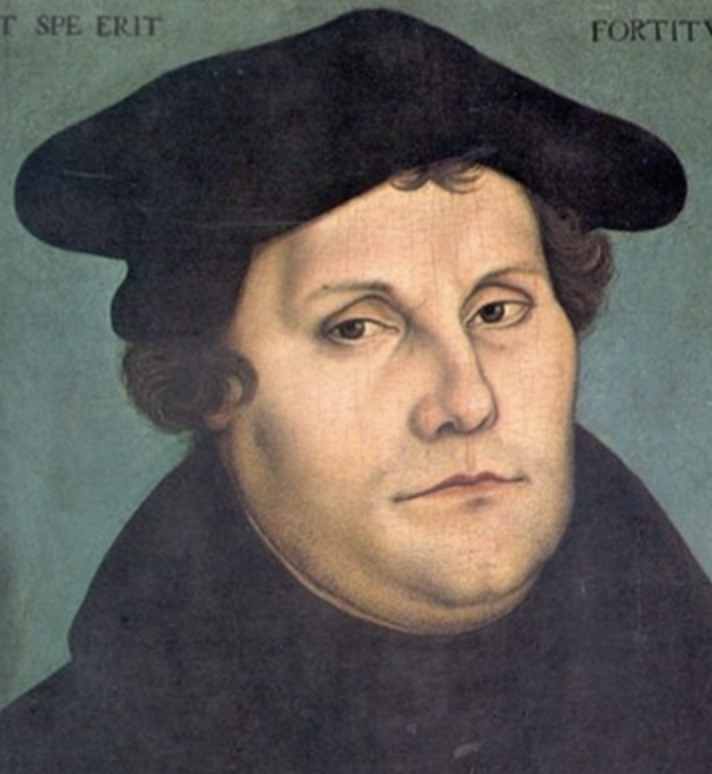
Martin Luther was born on November 10, 1483, in Eisleben, Saxony (now in modern-day Germany). His father, Hans Luther, was a miner, and his mother, Margarethe Luther, was a hardworking woman who attended to their family. In 1484, his family took up residence in Mansfeld where his father leased copper mines and smelters. In 1501, at age 17, Martin enrolled in the University of Erfurt which he would later describe as a beer house and whorehouse. At Erfurt he was awakened at 4:00 a.m. every morning for what was described as “a day of rote learning and wearying spiritual exercises.” In 1505, Martin graduated with a master’s degree. Although he originally pursued a career in jurisprudence, life-altering experience during a thunderstorm in 1505 prompted him to enter the Augustinian monastery in Erfurt.
Luther struggled with feelings of inadequacy and guilt in his monastic life, seeking spiritual peace through strict adherence to the monastic rules. He dedicated himself to prayer, fasting, and other ascetic practices. His theological breakthrough came through his study of the Bible, particularly the letters of Paul, as he came to believe that salvation comes through faith in Christ alone, not through good works or the sacraments of the Catholic Church. In 1507, at the age of 24, Luther was ordained to the priesthood of the Catholic Church. The next year, he was appointed to teach theology at the University of Wittenberg, and in March of that year, he received a bachelor’s degree in biblical studies and another bachelor’s degree in 1509. On October 19, 1512, Luther was awarded his Doctor of Philosophy and on October 21, 1512, was received into the senate of the theological faculty of the University of Wittenberg.
Luther spent the rest of his career at the University of Wittenberg, but on discovering that the Church was selling what were called “indulgences,” he began to realize that the Catholic Church was soliciting payments in return for reduced sentences in Purgatory. Consequently, he rejected several teachings and practices of the Church and in 1517, proposed in his Ninety-Five Theses, an academic discussion of the practice and efficacy of indulgences. On October 31, 1517, his famous “95 Theses” were nailed to the door of the Castle Church in Wittenberg. These theses challenged the Catholic Church’s sale of indulgences.
The printing press facilitated the spread of Luther’s ideas, leading to a broader movement known as the Protestant Reformation. In 1521, Luther was excommunicated by Pope Leo X, and was summoned to the Diet of Worms to recant his teachings. Refusing to recant, he famously declared, “Here I stand, I can do no other.” Luther was condemned by the Holy Roman Emperor as an “outlaw.” During the next five days, private conferences were held to determine Luther’s fate. On May 25, 1521, the Emperor presented the final draft of the Edict of Worms, declaring that Luther was an outlaw and demanding his arrest as a heretic. The edict also warned that anyone giving him food or shelter was guilty of collusion. Furthermore, It permitted anyone to kill Luther without legal consequence.
Fortunately, Luther was protected by Frederick III, Elector of Saxony, who protected him from the Pope’s enforcement of the edict by faking a highway attack on Luther’s journey to Wittenberg, and then hiding him at Wartburg Castle. Frederick III, also known as “Frederick the wise” had hedged his bets by accumulating at great cost, indulgences that provided him with 1,902,202 years worth of penance in Purgatory.
In the years that followed, Luther translated the New Testament into German, making the Bible more accessible to the common people. In 1525, Luther married Katharina von Bora, a former nun, breaking with the tradition of clerical celibacy. They had six children and provided a model for the Protestant understanding of marriage and family. Luther continued his theological writings and reforms, including the development of the Augsburg Confession, a key document in Lutheran theology.
Between 1531 and 1546 Luther suffered a variety of maladies including Ménière’s disease, vertigo, and tinnitus. In 1536, he began to suffer from kidney and bladder stones and by December 1544, he began to feel the effects of angina. As his health declined, he became more vitriolic in his writings and in his social relationships. On February 18, 1546, Martin Luther died in Eisleben, Saxony, the town in which he was born.
Martin Luther’s impact on Christianity was profound. The Lutheran Church, named after him, became one of the major Protestant denominations, and his teachings influenced the broader Protestant movement. His emphasis on the authority of Scripture and justification by faith alone shaped the theological landscape of the Reformation and left a lasting legacy in the Christian world.
Though many clerics railed against alcohol, Martin Luther once advanced a popular syllogism, “Whoever drinks beer, he is quick to sleep; whoever sleeps long, does not sin; whoever does not sin, enters Heaven! Thus, let us drink beer!”
